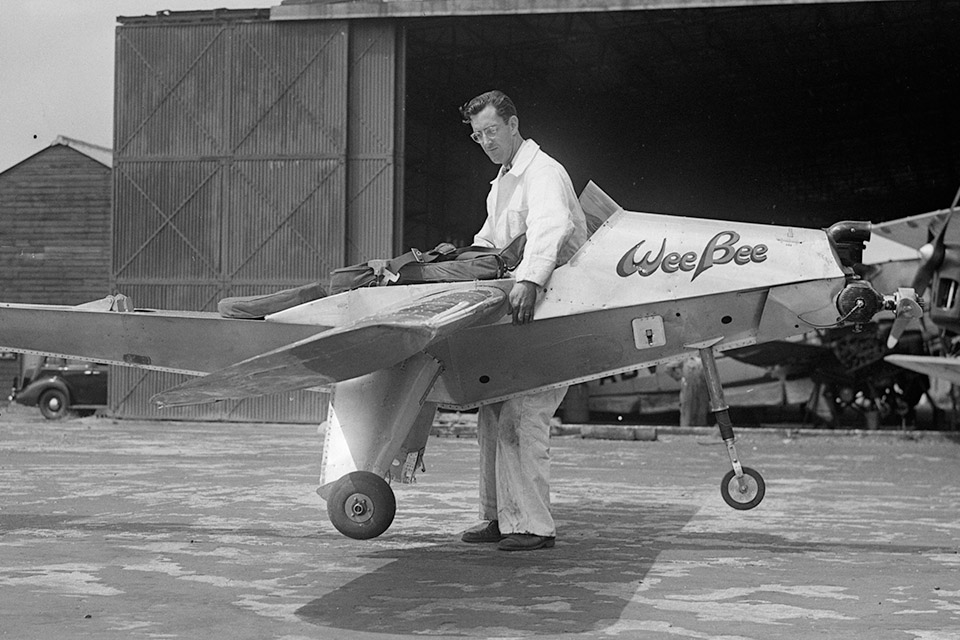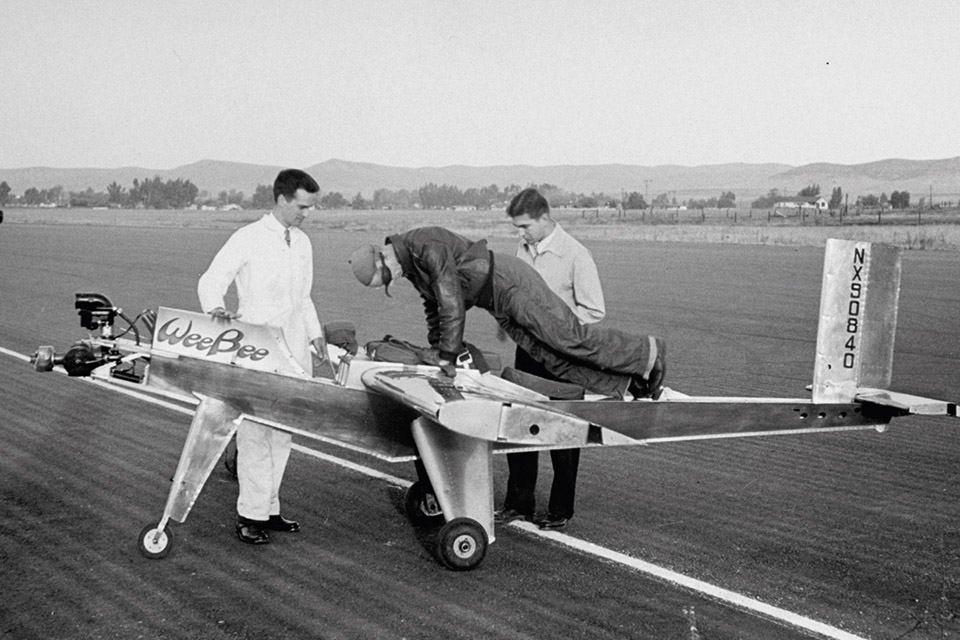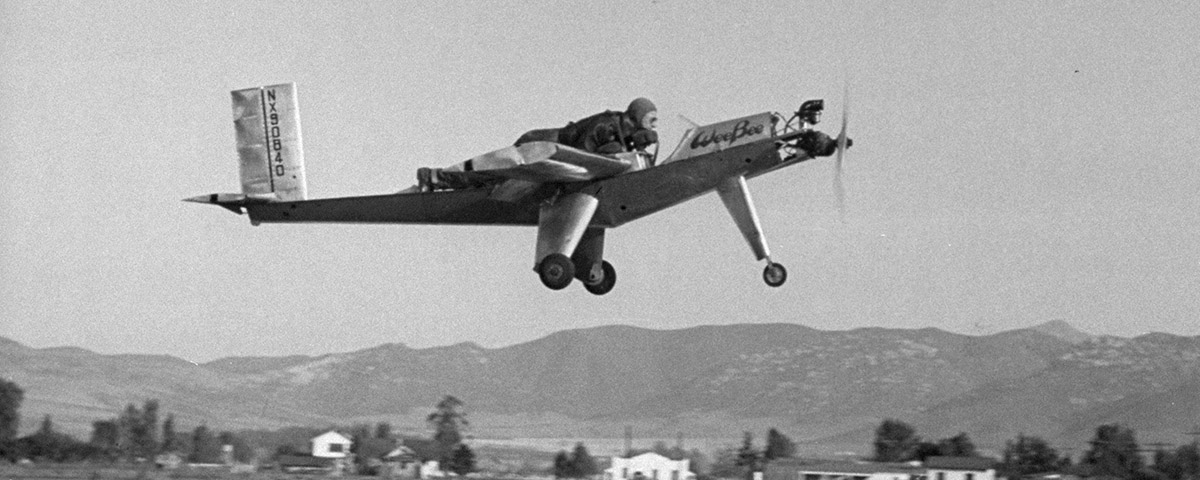In the late 1940s, a group of moonlighting engineers set out to build the world’s smallest piloted airplane.
People have been fascinated with giant airplanes throughout aviation history, naturally focusing on such standouts as Sikorsky’s Ilya Muromets, the World War I Zeppelin-Staaken R.VI, the Hughes Hercules flying boat, the Convair XC-99 and the current champion, the Antonov An-225. Public interest has even extended to some real clinkers, such as the early-1930s Kalinin K-7, to which Photoshop gave a new lease on life a few years ago, portraying it with cannon-filled turrets worthy of a battleship.
Small aircraft, by comparison, have flown under the radar. There have been many of these, especially during the earliest days of kit-built airplanes, when some very tiny, if improbable, planes were offered to buyers through magazine classified ads. Later, however, some excellent versions of small, economical aircraft, such as the Heath Parasol, appeared on the scene.
Interest in small airplanes increased during the Great Depression, when designs like the Pietenpol Camper and Corben Baby Ace received plenty of publicity and a degree of popularity. Paul Poberezny’s three articles in Mechanix Illustrated on his reinterpretation of the Baby Ace in 1956 gave that design a well-deserved boost. Almost all these smaller aircraft had wingspans in the 25-foot range and gross weights ranging from 500 to 1,000 pounds. None of them, however, was ever called “the world’s smallest airplane.”
The media spontaneously accorded that title to a diminutive aircraft called the Wee Bee in 1948, long before it was actually completed. A group of Convair engineers in San Diego, intent on creating the smallest possible plane that could carry a pilot, developed the design, and it caught the public fancy.
The late 1940s and early 1950s were intoxicating times in the aviation industry, when new and improved airplanes appeared across America almost every month. The idea to build the world’s smallest man-carrying aircraft originated with Ken Coward, whose original concept called for a balsa plane with an empty weight of 70 pounds. Coward joined forces with other Convair experts— Karl Montijo, James Wilder, Tom Bossart, A.B. Mandeville and Bill Chana—to explore the possibilities of extremely small aircraft.
Although Coward was the designer, Chana took a leading role in the project. Chana had been smitten with aviation at the age of 6, built award-winning model airplanes and studied aeronautical engineering at Purdue University. Determined to become a pilot, he went to work for Consolidated Aircraft in San Diego in June 1941. He served as a flight test engineer on an incredible series of aircraft, including the XB-24, XB-32, XPB4Y-2, XC-99, TBY-2, XF-92A, XFY-1 Pogo and the XF2Y-1 Sea Dart, in addition to Convair’s commercial airliners. He wanted to become a U.S. Army Air Forces pilot too, but couldn’t meet the physical requirements after suffering major burns in the crash of an XB-32.

Like Chana, the other engineers in the group were all engaged with ultra-secret programs during the day. Sundays they reserved for their families, but they devoted evenings and Saturdays to their own projects. Building the world’s smallest piloted plane became their challenge.
The group quickly decided that balsa was probably not the best material for the project, especially since tons of war-surplus aluminum sheet were available. The tools needed to fashion it were readily obtainable as well.
As engineers, they were well aware that while it is fairly easy to scale up an aircraft, it is far more difficult to scale it down, something that many who have attempted to build three-quarter-scale versions of World War II fighters have discovered. The difficulty is that while the dimensions go down linearly, areas go down by the square.
They came to an agreement on a preliminary design, an all-metal monoplane with the pilot lying prone atop a girder-like fuselage. They opted for a prone position for a number of reasons, including drag and weight reduction. The elevator control was beneath the pilot, but at relatively the same position as in a conventional aircraft, while the rudder pedals were in slots on the top of the fuselage.
An initial tail-dragger landing gear design was changed to tricycle gear built of spring steel rather than aluminum sheet. With hydraulic brakes and nose-gear steering, the Wee Bee was relatively sophisticated compared to other planes of its day.
The effects of reducing scale soon became apparent, however. While a Cessna 150 with a 32-foot-plus wingspan could taxi comfortably on stiff spring steel landing gear, it was different for a very small aircraft. What’s more, the difference in reaction to the spring steel gear made “feeling out” the controls while taxiing the Wee Bee difficult. Test pilots couldn’t determine the effect of the aileron during fast taxis because the landing gear was so stiff. There were also other, similar, scale anomalies.
The engineers worked together initially as Ken S. Coward & Associates, then were briefly called Beecraft Aviation Associates before becoming Bee Aviation Associates, with Chana as president. Group members had naively assumed that building a small aircraft would be relatively easy, but when problems cropped up, their experience as engineers made them extra cautious. As a result, the project was stretched out and included many redesigns.
They tackled the 15-foot wing first. Once that was completed, the San Diego Tribune Sun published an article on the project. The early publicity started the little airplane on its way—not to fortune, but to a measure of fame well before its first flight.
Working with diligence and enthusiasm, the engineers managed to get the aircraft (initially dubbed the Pee Wee) ready for taxi tests by August 1948. Those and subsequent tests would reveal a long series of unanticipated problems that had to be resolved before a genuine first flight could be attempted.
The first problem arose when the tail skid began carving up the asphalt runways of El Cajon’s Gillespie Field. A tail wheel was substituted, which helped the runways but not the taxiing, for the little aircraft wanted to ground loop whenever it reached 45 mph. It was also evident that the recycled Kiekhaefer O-45-1 target drone engine chosen for the plane was not generating enough power.
The change from tail-dragger to tricycle gear cured the ground-looping tendency. Given the plane’s small size and light weight, crafting a nose wheel and moving the main gear was relatively easy. The nose could now be lifted off the ground at 30 mph, allowing Bill Chana and Karl Montijo, who served as the primary test pilots, to check control effectiveness. Other challenges included testing various angles of incidence of both the wing and the tailplane, trying various flap angles and obtaining a more powerful engine.
Chana, by now a licensed pilot with 250 hours’ flying time, summoned his courage and skill on September 26, 1948, and hopped the little airplane into the air. He flew for less than 100 feet at an altitude of about one foot. Though it didn’t count as a first flight, it was the most encouraging effort thus far. Montijo, a far more experienced pilot, made a few hops, and both men agreed that the 18-hp drone engine lacked sufficient power to enable the plane to climb out of ground effect. While the aircraft did not seem difficult to control, Chana felt no urge to do steep turns.
Even as the group struggled to get their diminutive craft into the air, its fame was spreading. Mechanix Illustrated ran an article on the Wee Bee, as it was now called, and both Universal and Paramount News Reel companies wanted to film a demonstration flight.
Coward and his team felt they were almost but not quite ready for this. Montijo, who weighed 190 pounds, was clearly too heavy to make the flight, so they asked Bill Bouck, their hangar landlord, to take his place. At 140 pounds, Bouck cut 13 percent off the Wee Bee’s approximately 480-pound gross weight.
On November 20, Bouck, who had practiced the day before, flew the Wee Bee up and down the runway at about 30 feet, satisfying the newsreel cameramen. Film of that demonstration was shown in theaters across the country, also spreading its fame abroad.
Though the pilot with parachute had to be strapped in by ground crew, he could make an emergency release in flight. But given the low altitudes at which the Wee Bee was generally flown, the use of a parachute was problematic. The pilot’s chin rested on a thick pad, and the instruments were at eye level. Control reactions were eventually similar to those of lightplanes of the period, although this took some tuning to achieve.
The biggest challenge had been getting a sufficiently powerful engine. Chana solved this by driving to Ream Field in San Diego, where the Navy stored target drones. He walked into the hangar and identified himself to the Navy officer behind the counter. The man listened sympathetically, then told Chana to drive to the building’s back door. There the Navy officer loaded a brand-new 28-hp Kiekhaefer O-45-3 engine into his trunk. Evidently the hangar held dozens of surplus drone engines, and the officer knew that one more or less in the inventory wouldn’t matter.

The Wee Bee was already quite famous for an airplane that had not really made anything more than runway hops. The new engine made it possible for Montijo to make the first official flight on March 12, 1949. Chana and Coward held the aircraft back physically during the run-up, then walked to the halfway point on the 6,000-foot runway at Brown Field. Montijo duly started his takeoff roll, and by the time he passed the cheering Chana and Coward he was at an altitude of 40 feet and climbing. Montijo turned right, moving out into the traffic pattern, but he was still flying so low that he disappeared behind rough ground to the north of the field. They could not see or hear the airplane and were about to summon emergency help when Montijo appeared in the distance on final approach. After landing, Montijo told them that he had flown the pattern at 150 feet and 70 mph.
The first flight was both satisfying and revealing. It was obvious that the Wee Bee was not wee enough, and that both weight and drag would have to be reduced to make the aircraft practical. To address the weight problem, Montijo went on a diet.
Reducing drag was a bit more difficult. The wing incidence was substantially changed, from 5 to 19 degrees. The nose gear strut was shortened, and a new Sensenich propeller mounted. Fairings were installed on the junctures of the wing to the fuselage and the engine to fuel tanks.
On the next test flight, on April 20, Montijo’s lost weight and decision not to use a parachute reduced the gross weight by 5 percent. That 10-minute flight saw the airplane reach an altitude of 400 feet—an improvement, though clearly not enough for commercial sales. It garnered additional publicity, however, and after a more convincing test flight by Montijo, an agreement was made to ship the Wee Bee to the United Kingdom to appear at airshows in London and Belfast.
The group worked swiftly to further improve performance, adding wingtips that increased the span to 18 feet, and fixing the flaps in the up position. Thus modified, it was shipped to England via Queen Mary, with the crew following in a TWA Constellation. Despite Gatwick Airport’s Marston mat steel runway, the demonstration flight—the Wee Bee’s sixth official flight—went well before an appreciative audience. Bad weather canceled the flight at Belfast.
The next public demonstration was at the 1949 National Air Races in Cleveland. Montijo made a seven-minute flight that delighted the crowd, and two grand old picture magazines, Life and Look, ran a feature that helped to further spread the Wee Bee’s fame. Coward demonstrated his sales pitch that “the Wee Bee was big enough to lift a man and small enough to be lifted by a man” by wrapping his arm around the airplane and lifting it off the ground.
Even after seven flights, however, the Wee Bee still needed improvement, so Chana took charge of a final series of fixes to increase performance. The wing incidence was altered again, from 19 degrees to 12, along with other changes that included a handle to lock the brakes, modifications to the control settings and reduction in control cable friction. The newsreel companies were still smitten with the Wee Bee, and Chana made a series of flights for them on March 11, 1950, achieving a top speed of 82 mph.
The Wee Bee’s 13th and last flight came on April 20, 1950. The group had submitted an unsolicited proposal to the U.S. Air Force for a military version called the Military Mite, armed with six underwing rockets. This proposal called for folding wings for ground transportation and a guarantee that the aircraft could take off and land on any road. Chana went all out on this demonstration flight, making 60-degree banks to the right and left, flying figure eights over a highway and delivering a low, high-speed pass. Unfortunately, the Air Force was not interested.
The Wee Bee then began life as a static exhibit at airshows before it was eventually put on display in the newly opened San Diego Aerospace Museum. Sadly, when an arsonist set fire to the largely wooden structure, the Wee Bee was destroyed. A replica can now be seen in the new San Diego Air and Space Museum in Balboa Park.
The group that developed the Wee Bee went on to other projects, building far more conventional aircraft. The first was the very attractive and long-lived Honey Bee, followed by the handsome four-place Queen Bee. Both of those airplanes had potential, but competition and the economy kept them from being produced in quantity.
All the group’s engineers went on to productive careers in the industry, with Bill Chana (who died on August 3, 2012) in particular distinguishing himself in a variety of important jobs. There is no doubt that after conquering all the challenges presented by building the world’s smallest aircraft, any subsequent task seemed easy to them.
Contributing editor Walter J. Boyne is a retired U.S. Air Force colonel, former director of the National Air and Space Museum and author of more than 50 books on aviation. He notes that YouTube has a film of Bill Chana, whom he knew well, “flying the Wee Bee like a pro.”
This feature was originally published in the July 2013 issue of Aviation History. To subscribe, click here.





